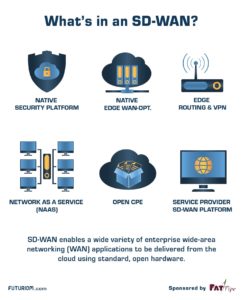What’s in an SD-WAN?
What’s in an SD-WAN?
By R. Scott Raynovich, Principal Analyst Futuriom
Software-defined wide-area networking (SD-WAN) technology combines many desired enterprise networking features – including security, bandwidth optimization, and application acceleration – and delivers them with a cloud-managed networking architecture.
One of the primary benefits of SD-WAN technology is that it implements new network services and features in software, without requiring hardware upgrades. Enterprise and service-provider buyers are interested in the multiple benefits of SD-WAN, including improving and managing broadband Internet, reducing network costs for both connectivity and operating expense (opex), and improved management and automation. Service providers are aware of this trend and are scrambling to put together managed services offerings, as their MPLS offerings will clearly be replaced by SD-WAN services in the long term.
The Network’s Cloud Evolution
One of the big trends with information technology is the move to the cloud. Enterprises now expect to buy IT services, on-demand, from the cloud. The network is moving to the cloud as well. Enterprise network managers seek the agility and flexibility of managing their network from the cloud, while at the same time getting locked into proprietary equipment on expensive private lines. Gains in Internet availability and bandwidth optimization technology, such as WAN optimization, de-duplication, load-balancing, and link balancing, have become more sophisticated, enabling enterprises to leverage Internet broadband for business applications. This is driving the rapid expansion of the SD-WAN market, which provides all of this functionality in a cloud-delivered model
The Network’s Cloud Evolution
Futuriom’s ongoing interviews with enterprise end users as well as service providers delivering SD-WAN reveals the following goals in connecting the WAN in these new cloud environments:
- Optimize and accelerate WAN traffic to the cloud
- Improve overall network security
- Reduce costs related to WAN bandwidth
- Leverage multiple access technologies such as fiber, DSL, and wireless
- Increased flexibility in CPE so that management can be outsourced or updated with software-only upgrades
- Improve capability to purchase, provision, and manage network services via the cloud, using software
Customers can solve all of these problems with a single SD-WAN offering that addresses these challenges with specific features. Take a look at the features that can now be typically included in an SD-WAN package:
Let’s highlight why all of these SD-WAN features are important.
Router replacement and Open CPE: Managing proprietary hardware and customer premises equipment (CPE), including branch-office routers, can be expensive and time consuming. SD-WAN can be used to simplify the deployment and management of CPE – especially if you are a retail company that has to manage hundreds or thousands of branches. SD-WAN functionality can be delivered on open, commercial off-the-shelf (COTS) hardware and managed from the cloud, helping to streamline and automate management.
Enhanced Security and Cloud VPN: One of the allures of SD-WAN technology is that it can be used to deploy a virtual private network (VPN) as a software overlay using end-to-end encryption. This helps meet security requirements for businesses that may want to connect branch offices or retail outlets but also have high security requirements. But SD-WAN platforms can also be used to deliver value-added security services such as stronger encryption, malware detection, and intrusion detection services (IDS). Security is becoming an important checklist item for SD-WAN.
WAN Optimization: SD-WAN can be used to improve the performance of applications on the network. WAN optimization, once a discrete function delivered with a hardware or software appliances, is being integrated into SD-WAN functionality. Many SD-WAN technologies include WAN optimization functionality and we expect this to be a checklist item in SD-WAN deployments.
Application Performance Enhancement: Cloud WAN solutions can be built that optimize access to cloud applications by monitoring traffic and routing higher-priority business applications ahead of leisure services such as Netflix and YouTube. Additionally, many WAN services can peer directly with cloud services to offer a “fast lane” to the business applications. These techniques can be used to “offload” enterprise WAN backhaul, routing cloud traffic directly to the source using a combination of broadband technologies. This will also have the effect of challenging the traditional ADC model of providing these services as part of a discrete hardware device. In addition, some SD-WAN vendors are working with cloud vendors to set up specialized cloud gateways and POPs in cloud datacenters to provide more direct access to cloud applications.
Cloud Management: As we have outlined, SD-WAN functionality can be deployed using COTS hardware and then managed from the cloud. This means that new network features, functionality, and updates can be managed with software over the network, rather than forklift upgrades, yielding a network-as-a-service model.
The SD-WAN market is now rapidly moving to customer deployments and accelerating because it delivers a more flexible, agile, and feature-rich platform to manage the enterprise WAN. Futuriom believes that in 2019 the market will continue to accelerate and drive into the billions of dollars, as it replaces some legacy technologies for VPN, ADC, edge routers, and firewalls. The market is consolidating around software-delivered and adaptive WAN services that can connect either through thin customer clients or industry-standard CPE.
FatPipe Networks have been selling software defined networking solutions for over 20 years and have specialized in providing customers with best of breed security, (one of the only SD-WAN providers with FIPS 140-2 government certification) reliability, flexibility (can support up to 15 interfaces in one device) and is easy to manage, providing a single pane interface view of the entire network.
FatPipe Networks www.fatpipeinc.com

